The Cambridge History of China. Vol. 06. Alien Regimes and Border States, 907-1368
Подождите немного. Документ загружается.

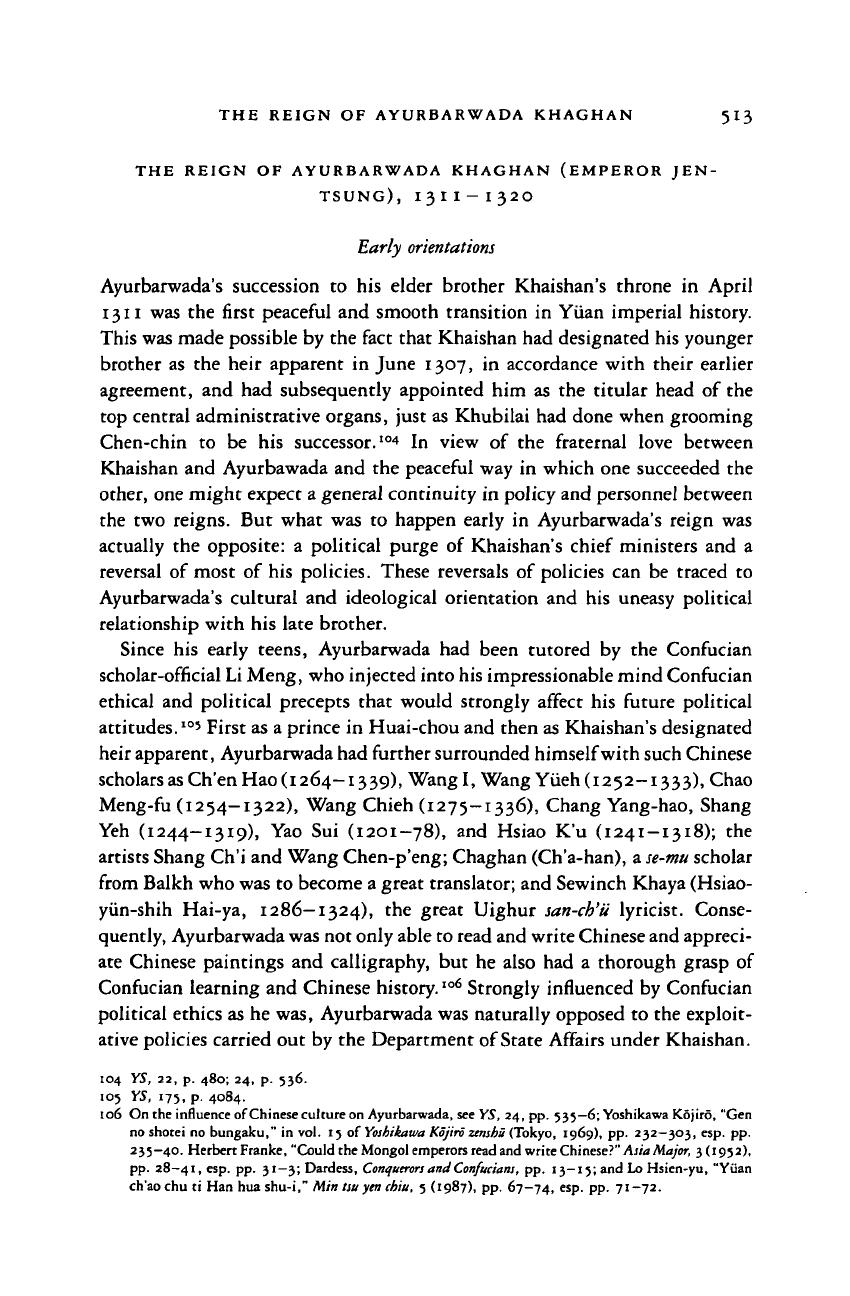
THE REIGN OF
AYURBARWADA
KHAGHAN
513
THE REIGN OF
AYURBARWADA
KHAGHAN
(EMPEROR JEN-
TSUNG),
13
I I
-
I
320
Early orientations
Ayurbarwada's succession to his elder brother Khaishan's throne in April
1311 was the first peaceful and smooth transition in Yuan imperial history.
This was made possible by the fact that Khaishan had designated his younger
brother as the heir apparent in June 1307, in accordance with their earlier
agreement, and had subsequently appointed him as the titular head of the
top central administrative organs, just as Khubilai had done when grooming
Chen-chin to be his successor.
104
In view of the fraternal love between
Khaishan and Ayurbawada and the peaceful way in which one succeeded the
other, one might expect a general continuity in policy and personnel between
the two reigns. But what was to happen early in Ayurbarwada's reign was
actually the opposite: a political purge of Khaishan's chief ministers and a
reversal of most of his policies. These reversals of policies can be traced to
Ayurbarwada's cultural and ideological orientation and his uneasy political
relationship with his late brother.
Since his early teens, Ayurbarwada had been tutored by the Confucian
scholar-official Li Meng, who injected into his impressionable mind Confucian
ethical and political precepts that would strongly affect his future political
attitudes.
10
' First as a prince in Huai-chou and then as Khaishan's designated
heir apparent, Ayurbarwada had further surrounded himself with such Chinese
scholars as Ch'enHao(
1264—1339),
Wang I, Wang Yiieh (1252—1333), Chao
Meng-fu (1254-1322), Wang Chieh (1275-1336), Chang Yang-hao, Shang
Yeh (1244-1319), Yao Sui (1201-78), and Hsiao K'u (1241-1318); the
artists Shang Ch'i and Wang Chen-p'eng; Chaghan (Ch'a-han), a
se-mu
scholar
from Balkh who was to become a great translator; and Sewinch Khaya (Hsiao-
yiin-shih Hai-ya, 1286-1324), the great Uighur san-ch'ii lyricist. Conse-
quently, Ayurbarwada was not only able to read and write Chinese and appreci-
ate Chinese paintings and calligraphy, but he also had a thorough grasp of
Confucian learning and Chinese history.
Io6
Strongly influenced by Confucian
political ethics as he was, Ayurbarwada was naturally opposed to the exploit-
ative policies carried out by the Department of State Affairs under Khaishan.
104 YS, 22, p. 480; 24, p. 536.
105 YS, 175, p. 4084.
106 On the influence of Chinese culture on Ayurbarwada, see YS, 24, pp. 535—6; Yoshikawa Kojiro, "Gen
no shotei no bungaku," in vol. 15 of Yosbikawa Kojiro
zenshu
(Tokyo, 1969), pp. 232—303, esp. pp.
235-40. Herbert Franke, "Could the Mongol emperors read and write
Chinese?"
Asia
Major,
3 (1952),
pp.
28—41,
esp. pp. 31-3; Dardess,
Conquerors
and
Confucians,
pp. 13-15; and Lo Hsien-yu, "Yuan
ch'aochu ti Han hua shu-i," Min tsu yen chiu, 5 (1987), pp. 67—74,
es
P- PP- 7'~7
2
-
Cambridge Histories Online © Cambridge University Press, 2008
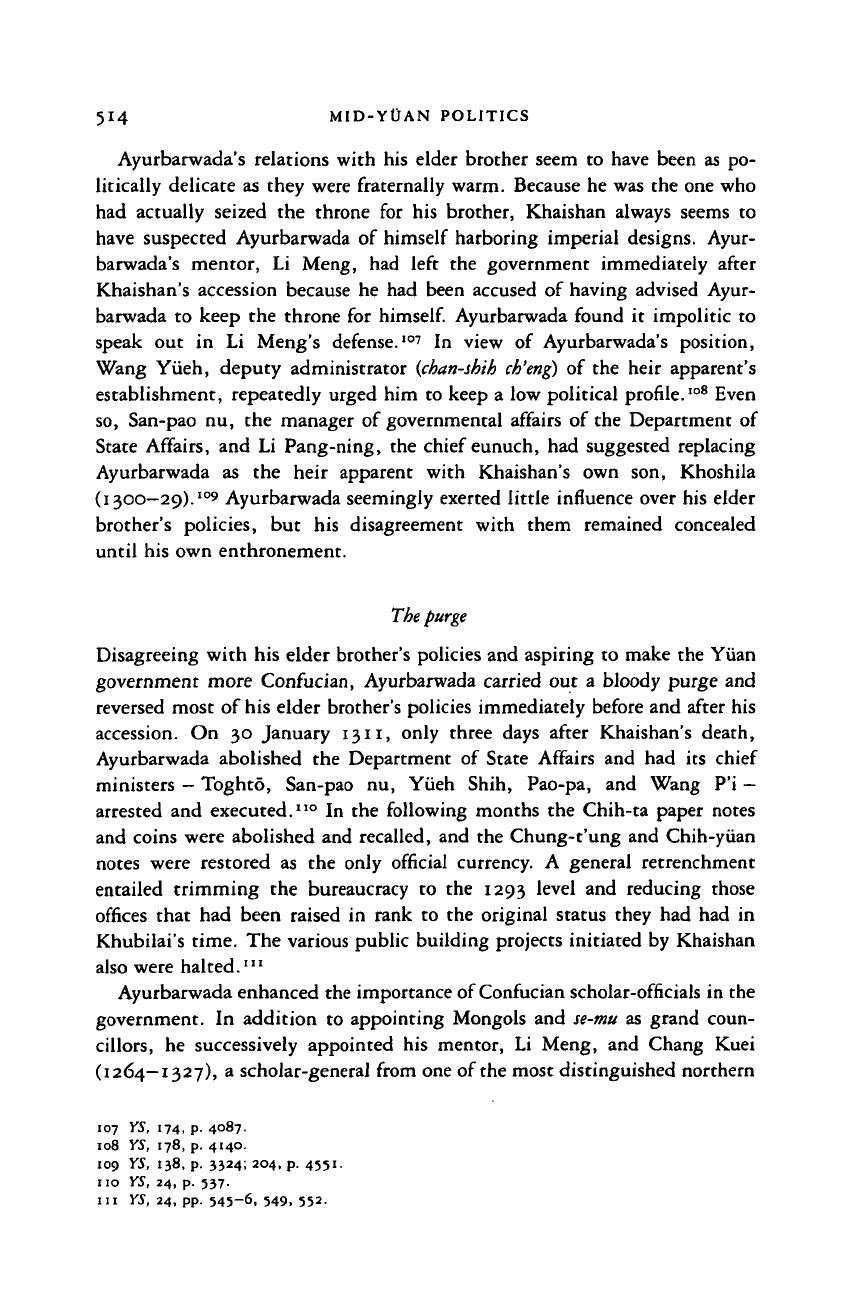
514
MID-YOAN
POLITICS
Ayurbarwada's relations with his elder brother seem to have been as po-
litically delicate as they were fraternally warm. Because he was the one who
had actually seized the throne for his brother, Khaishan always seems to
have suspected Ayurbarwada of himself harboring imperial designs. Ayur-
barwada's mentor, Li Meng, had left the government immediately after
Khaishan's accession because he had been accused of having advised Ayur-
barwada to keep the throne for
himself.
Ayurbarwada found it impolitic to
speak out in Li Meng's defense.
107
In view of Ayurbarwada's position,
Wang Yiieh, deputy administrator
(chan-shih ch'eng)
of the heir apparent's
establishment, repeatedly urged him to keep a low political profile.
108
Even
so,
San-pao nu, the manager of governmental affairs of the Department of
State Affairs, and Li Pang-ning, the chief eunuch, had suggested replacing
Ayurbarwada as the heir apparent with Khaishan's own son, Khoshila
(i 300-29).
IO9
Ayurbarwada seemingly exerted little influence over his elder
brother's policies, but his disagreement with them remained concealed
until his own enthronement.
The
purge
Disagreeing with his elder brother's policies and aspiring to make the Yuan
government more Confucian, Ayurbarwada carried out a bloody purge and
reversed most of his elder brother's policies immediately before and after his
accession. On 30 January 1311, only three days after Khaishan's death,
Ayurbarwada abolished the Department of State Affairs and had its chief
ministers - Toghtd, San-pao nu, Yiieh Shih, Pao-pa, and Wang P'i -
arrested and executed.
110
In the following months the Chih-ta paper notes
and coins were abolished and recalled, and the Chung-t'ung and Chih-yuan
notes were restored as the only official currency. A general retrenchment
entailed trimming the bureaucracy to the 1293 level and reducing those
offices that had been raised in rank to the original status they had had in
Khubilai's time. The various public building projects initiated by Khaishan
also were halted.
111
Ayurbarwada enhanced the importance of Confucian scholar-officials in the
government. In addition to appointing Mongols and
se-mu
as grand coun-
cillors, he successively appointed his mentor, Li Meng, and Chang Kuei
(1264—1327), a scholar-general from one of the most distinguished northern
107 YS,
174,
p.
4087.
108
YS,
178,
p.
4140.
109 YS,
138,
p.
3324;
204,
p.
4551.
no
YS,
24,
p.
537.
in YS,
24,
pp. 545-6, 549, 552.
Cambridge Histories Online © Cambridge University Press, 2008
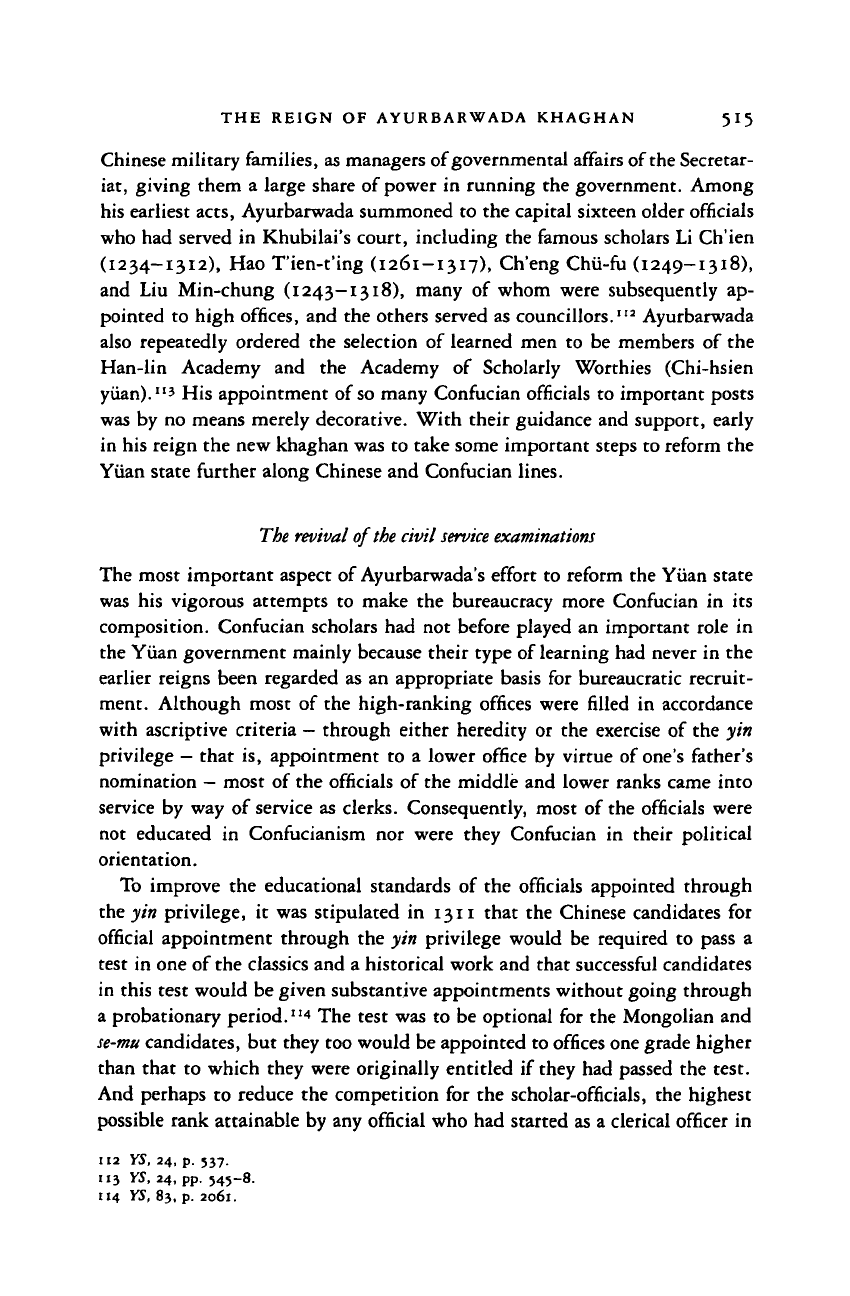
THE REIGN OF AYURBARWADA KHAGHAN 515
Chinese military families, as managers of governmental affairs of the Secretar-
iat, giving them a large share of power in running the government. Among
his earliest acts, Ayurbarwada summoned to the capital sixteen older officials
who had served in Khubilai's court, including the famous scholars Li Ch'ien
(1234—1312), Hao T'ien-t'ing
(1261
—1317),
Ch'eng Chii-fu (1249—1318),
and Liu Min-chung (1243-1318), many of whom were subsequently ap-
pointed to high offices, and the others served as councillors."
2
Ayurbarwada
also repeatedly ordered the selection of learned men to be members of the
Han-lin Academy and the Academy of Scholarly Worthies (Chi-hsien
yuan)."'
His appointment of so many Confucian officials to important posts
was by no means merely decorative. With their guidance and support, early
in his reign the new khaghan was to take some important steps to reform the
Yiian state further along Chinese and Confucian lines.
The revival of the civil
service
examinations
The most important aspect of Ayurbarwada's effort to reform the Yiian state
was his vigorous attempts to make the bureaucracy more Confucian in its
composition. Confucian scholars had not before played an important role in
the Yiian government mainly because their type of learning had never in the
earlier reigns been regarded as an appropriate basis for bureaucratic recruit-
ment. Although most of the high-ranking offices were filled in accordance
with ascriptive criteria - through either heredity or the exercise of the yin
privilege - that is, appointment to a lower office by virtue of one's father's
nomination - most of the officials of the middle and lower ranks came into
service by way of service as clerks. Consequently, most of the officials were
not educated in Confucianism nor were they Confucian in their political
orientation.
To improve the educational standards of the officials appointed through
the yin privilege, it was stipulated in 1311 that the Chinese candidates for
official appointment through the yin privilege would be required to pass a
test in one of the classics and a historical work and that successful candidates
in this test would be given substantive appointments without going through
a probationary period. "* The test was to be optional for the Mongolian and
se-mu
candidates, but they too would be appointed to offices one grade higher
than that to which they were originally entitled if they had passed the test.
And perhaps to reduce the competition for the scholar-officials, the highest
possible rank attainable by any official who had started as a clerical officer in
112 YS, 24, p. 537.
113 YS, 24, pp. 545-8.
114 YS, 83, p. 2061.
Cambridge Histories Online © Cambridge University Press, 2008
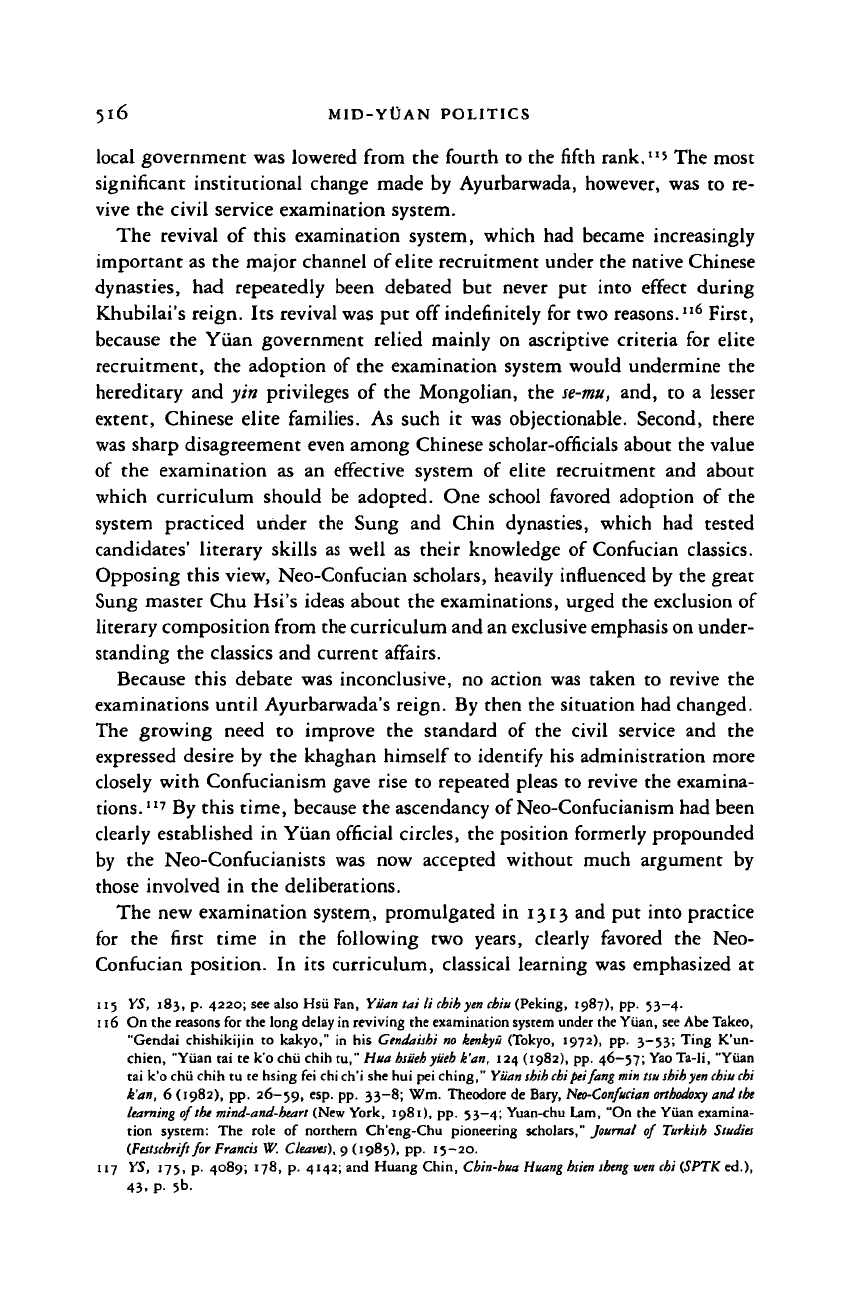
516 MID-YOAN POLITICS
local government was lowered from the fourth to the fifth rank."5 The most
significant institutional change made by Ayurbarwada, however, was to re-
vive the civil service examination system.
The revival of this examination system, which had became increasingly
important as the major channel of elite recruitment under the native Chinese
dynasties, had repeatedly been debated but never put into effect during
Khubilai's reign. Its revival was put off indefinitely for two reasons."
6
First,
because the Yuan government relied mainly on ascriptive criteria for elite
recruitment, the adoption of the examination system would undermine the
hereditary and yin privileges of the Mongolian, the
se-mu,
and, to a lesser
extent, Chinese elite families. As such it was objectionable. Second, there
was sharp disagreement even among Chinese scholar-officials about the value
of the examination as an effective system of elite recruitment and about
which curriculum should be adopted. One school favored adoption of the
system practiced under the Sung and Chin dynasties, which had tested
candidates' literary skills as well as their knowledge of Confucian classics.
Opposing this view, Neo-Confucian scholars, heavily influenced by the great
Sung master Chu Hsi's ideas about the examinations, urged the exclusion of
literary composition from the curriculum and an exclusive emphasis on under-
standing the classics and current affairs.
Because this debate was inconclusive, no action was taken to revive the
examinations until Ayurbarwada's reign. By then the situation had changed.
The growing need to improve the standard of the civil service and the
expressed desire by the khaghan himself to identify his administration more
closely with Confucianism gave rise to repeated pleas to revive the examina-
tions.
117
By this time, because the ascendancy of Neo-Confucianism had been
clearly established in Yuan official circles, the position formerly propounded
by the Neo-Confucianists was now accepted without much argument by
those involved in the deliberations.
The new examination system, promulgated in 1313 and put into practice
for the first time in the following two years, clearly favored the Neo-
Confucian position. In its curriculum, classical learning was emphasized at
115 YS, 183, p. 4220; see also Hsii Fan, Yuan tai li
chih
yen cbiu (Peking, 1987), pp. 53-4.
116 On the reasons for the long delay in reviving the examination system under the Yuan, see Abe Takeo,
"Gendai chishikijin to kakyo," in his Genda'tshi no kenkyu (Tokyo, 1972), pp. 3-33; Ting K'un-
chien, "Yuan tai te k'o chii chih tu," Hua
hsiiehyiieh
k'an, 124 (1982), pp. 46-57; Yao Ta-li, "Yiian
tai k'o chii chih tu te hsing fei chi ch'i she hui pei ching," Yuan shib
chi
pet fang
min tsu
shib
yen
cbiu cbi
k'an,
6 (1982), pp. 26-59, esp. pp. 33-8; Wm. Theodore de Bary,
Neo-Confucian orthodoxy
and
the
teaming of the mind-and-heart (New York, 1981), pp. 53—4; Yuan-chu Lam, "On the Yiian examina-
tion system: The role of northern Ch'eng-Chu pioneering scholars," Journal of Turkish Studies
(Festschrift
for Francis W. Cleaves), 9 (1985), pp. 15-20.
117 YS, 175, p. 4089; 178, p. 4142; and Huang Chin, Chin-hua Huang
hsien sheng
wen chi (SPTK ed.),
43.
P- 5b-
Cambridge Histories Online © Cambridge University Press, 2008
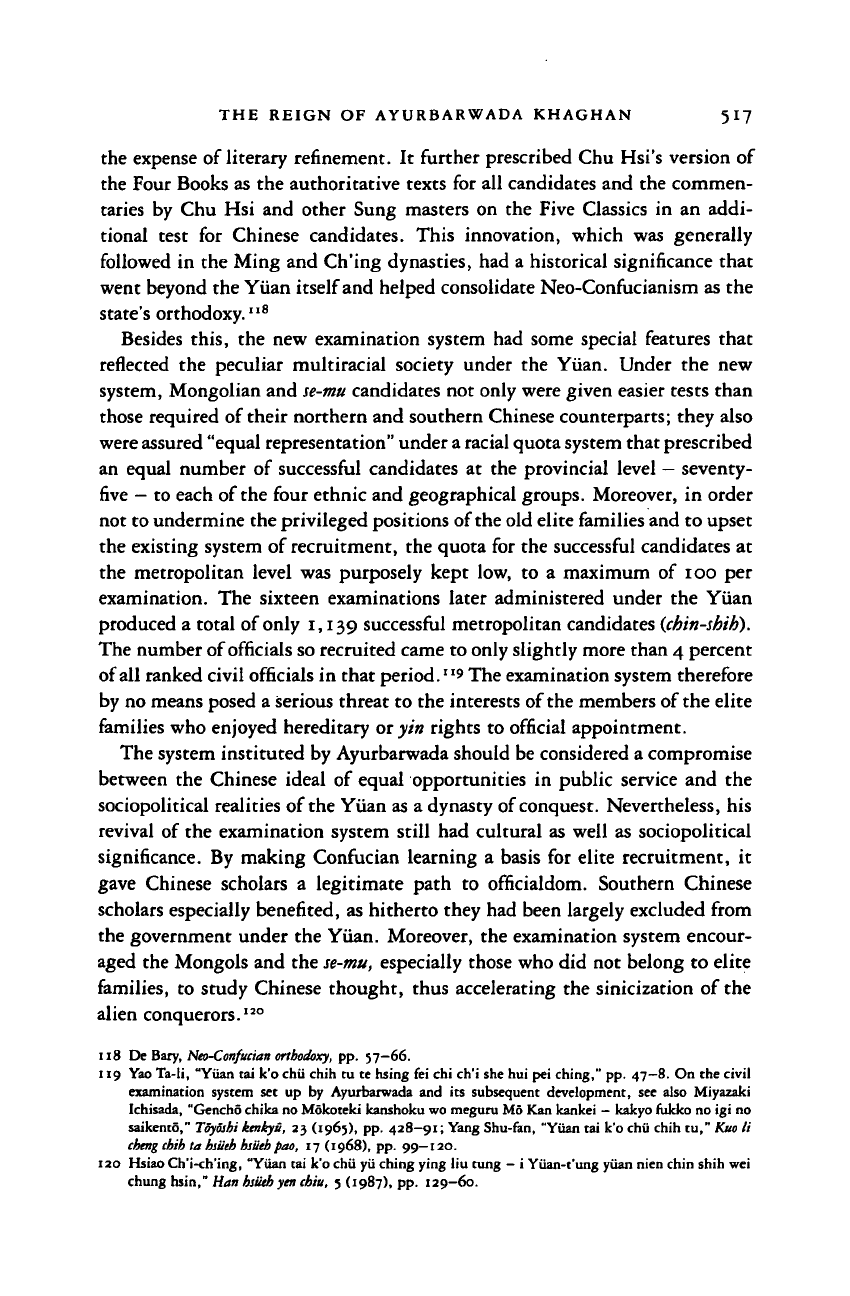
THE REIGN OF AYURBARWADA KHAGHAN 517
the expense of literary refinement. It further prescribed Chu Hsi's version of
the Four Books as the authoritative texts for all candidates and the commen-
taries by Chu Hsi and other Sung masters on the Five Classics in an addi-
tional test for Chinese candidates. This innovation, which was generally
followed in the Ming and Ch'ing dynasties, had a historical significance that
went beyond the Yuan itself and helped consolidate Neo-Confucianism as the
state's orthodoxy."
8
Besides this, the new examination system had some special features that
reflected the peculiar multiracial society under the Yuan. Under the new
system, Mongolian and
se-mu
candidates not only were given easier tests than
those required of their northern and southern Chinese counterparts; they also
were assured "equal representation" under a racial quota system that prescribed
an equal number of successful candidates at the provincial level - seventy-
five - to each of the four ethnic and geographical groups. Moreover, in order
not to undermine the privileged positions of the old elite families and to upset
the existing system of recruitment, the quota for the successful candidates at
the metropolitan level was purposely kept low, to a maximum of ioo per
examination. The sixteen examinations later administered under the Yuan
produced a total of only 1,139 successful metropolitan candidates (chin-shih).
The number of officials so recruited came to only slightly more than 4 percent
of all ranked civil officials in that period. "
9
The examination system therefore
by no means posed a serious threat to the interests of the members of the elite
families who enjoyed hereditary or yin rights to official appointment.
The system instituted by Ayurbarwada should be considered a compromise
between the Chinese ideal of equal opportunities in public service and the
sociopolitical realities of the Yuan as a dynasty of conquest. Nevertheless, his
revival of the examination system still had cultural as well as sociopolitical
significance. By making Confucian learning a basis for elite recruitment, it
gave Chinese scholars a legitimate path to officialdom. Southern Chinese
scholars especially benefited, as hitherto they had been largely excluded from
the government under the Yuan. Moreover, the examination system encour-
aged the Mongols and the
se-mu,
especially those who did not belong to elite
families, to study Chinese thought, thus accelerating the sinicization of the
alien conquerors.
120
118 De Bary,
Neo-Confucian
orthodoxy,
pp. 57—66.
119 Yao Ta-ti, "Yuan tai k'o chii chih cu te hsing fei chi ch'i she hui pei ching," pp. 47—8. On the civil
examination system set up by Ayurbarwada and its subsequent development, see also Miyazaki
Ichisada, "Gencho chika no Mokoteki kanshoku wo meguru Mo Kan kankei - kakyo fukko no igi no
saikento,"
Tayoshi
kmkyu, 23 (1965), pp. 428—91; Yang Shu-fan, "Yuan tai k'o chii chih tu," Kuo li
chevg chih
ta hsiith
hsiith
pao, 17 (1968), pp. 99—120.
120 Hsiao Ch'i-ch'ing, "Yuan tai k'o chii yii ching ying liu tung - i Yiian-t'ung yuan nien chin shih wei
chung hsin," Han
hsiith
yen chiu, 5 (1987), pp. 129—60.
Cambridge Histories Online © Cambridge University Press, 2008
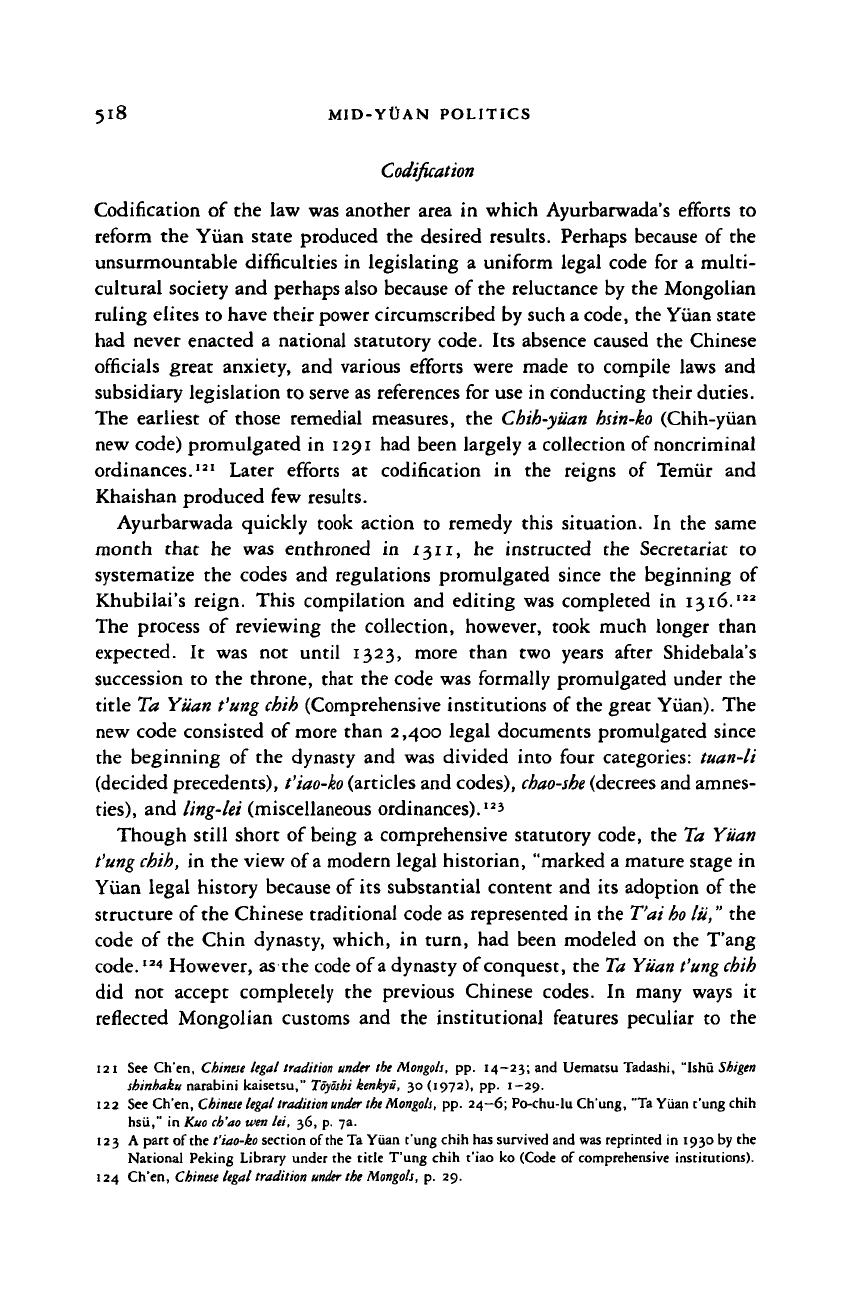
518 MID-YOAN POLITICS
Codification
Codification of the law was another area in which Ayurbarwada's efforts to
reform the Yuan state produced the desired results. Perhaps because of the
unsurmountable difficulties in legislating a uniform legal code for a multi-
cultural society and perhaps also because of the reluctance by the Mongolian
ruling elites to have their power circumscribed by such a code, the Yuan state
had never enacted a national statutory code. Its absence caused the Chinese
officials great anxiety, and various efforts were made to compile laws and
subsidiary legislation to serve as references for use in conducting their duties.
The earliest of those remedial measures, the
Chih-yiian hsin-ko
(Chih-yuan
new code) promulgated in 1291 had been largely a collection of noncriminal
ordinances.
121
Later efforts at codification in the reigns of Temiir and
Khaishan produced few results.
Ayurbarwada quickly took action to remedy this situation. In the same
month that he was enthroned in 1311, he instructed the Secretariat to
systematize the codes and regulations promulgated since the beginning of
Khubilai's reign. This compilation and editing was completed in 1316.
122
The process of reviewing the collection, however, took much longer than
expected. It was not until 1323, more than two years after Shidebala's
succession to the throne, that the code was formally promulgated under the
title Ta Yuan t'ung
chih
(Comprehensive institutions of the great Yuan). The
new code consisted of more than 2,400 legal documents promulgated since
the beginning of the dynasty and was divided into four categories: tuan-li
(decided precedents),
t'iao-ko
(articles and codes),
chao-she
(decrees and amnes-
ties),
and
ling-lei
(miscellaneous ordinances).
123
Though still short of being a comprehensive statutory code, the Ta Yuan
t'ung
chih,
in the view of
a
modern legal historian, "marked a mature stage in
Yuan legal history because of its substantial content and its adoption of the
structure of the Chinese traditional code as represented in the T'ai
bo
lit," the
code of the Chin dynasty, which, in turn, had been modeled on the T'ang
code.
I24
However, as the code of a dynasty of conquest, the
Ta Yuan
t'ung
chih
did not accept completely the previous Chinese codes. In many ways it
reflected Mongolian customs and the institutional features peculiar to the
121 See Ch'en, Chinese legal tradition under the Mongols, pp. 14—23; and Uematsu Tadashi, "Ishu Shigen
shinhaku narabini kaisetsu,"
Toyoshi
kenkyu, 30 (1972), pp. 1-29.
122 See Ch'en,
Chinese
legal tradition
under the
Mongols,
pp. 24—6; Po-chu-lu Ch'ung, "Ta Yuan t'ung chih
hsii," in Kuo
ch'ao
wen lei, 36, p. 7a.
123 A part of the t'iao-ko section of
the
Ta Yuan t'ung chih has survived and was reprinted in 1930 by the
National Peking Library under the title T'ung chih t'iao ko (Code of comprehensive institutions).
124 Ch'en,
Chinese
legal tradition
under
the
Mongols,
p. 29.
Cambridge Histories Online © Cambridge University Press, 2008
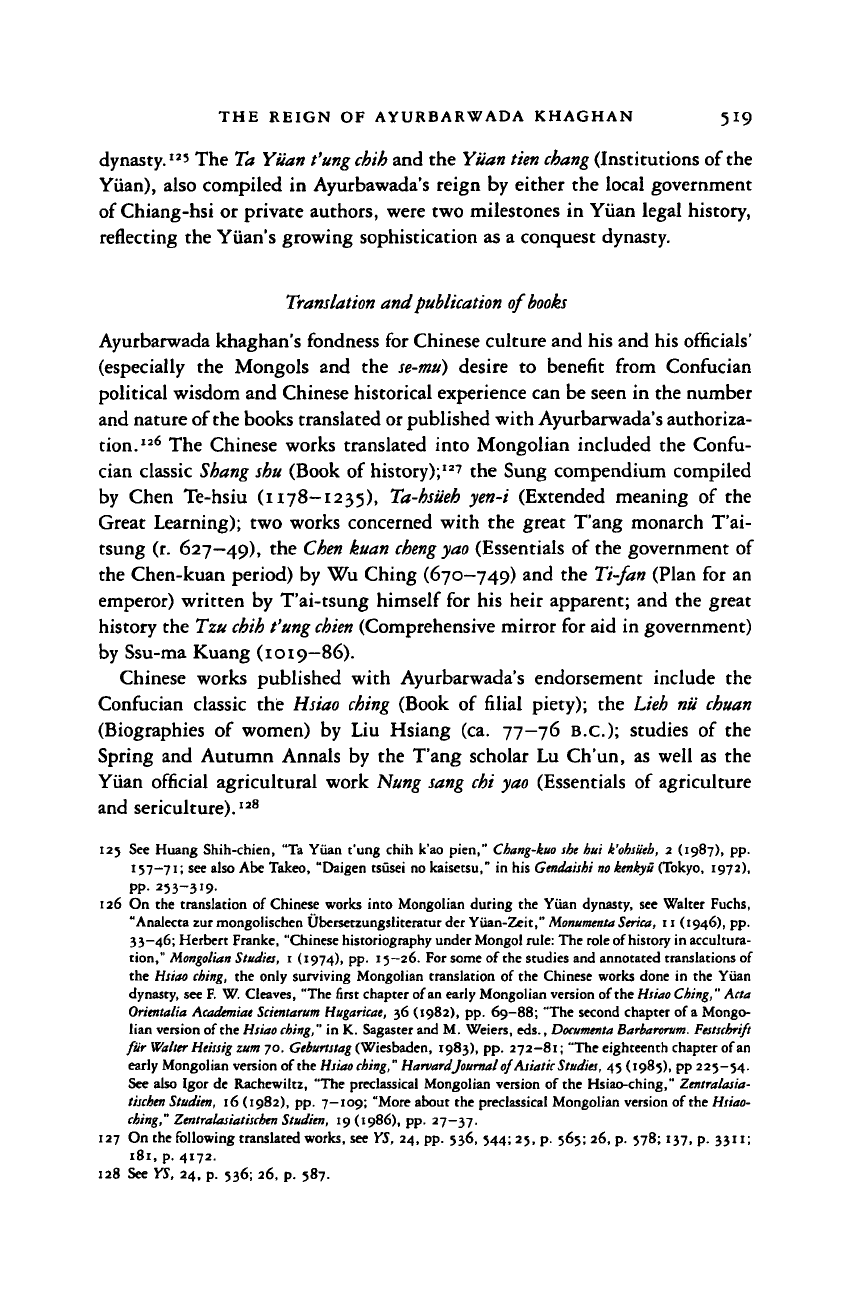
THE REIGN OF AYURBARWADA KHAGHAN 519
dynasty.
12
' The Ta Yuan t'ung
chih
and the Yuan tien
chang
(Institutions of the
Yuan),
also compiled in Ayurbawada's reign by either the local government
of Chiang-hsi or private authors, were two milestones in Yuan legal history,
reflecting the Yiian's growing sophistication as a conquest dynasty.
Translation and publication of books
Ayurbarwada khaghan's fondness for Chinese culture and his and his officials'
(especially the Mongols and the se-mu) desire to benefit from Confucian
political wisdom and Chinese historical experience can be seen in the number
and nature of the books translated or published with Ayurbarwada's authoriza-
tion.
126
The Chinese works translated into Mongolian included the Confu-
cian classic Shang shu (Book of history);
127
the Sung compendium compiled
by Chen Te-hsiu (1178-1235), Ta-hsueh yen-i (Extended meaning of the
Great Learning); two works concerned with the great T'ang monarch T'ai-
tsung (r. 627-49), the Chen kuan
cheng
yao (Essentials of the government of
the Chen-kuan period) by Wu Ching (670-749) and the Ti-fan (Plan for an
emperor) written by T'ai-tsung himself for his heir apparent; and the great
history the Tzu chih t'ung
chien
(Comprehensive mirror for aid in government)
by Ssu-ma Kuang (1019-86).
Chinese works published with Ayurbarwada's endorsement include the
Confucian classic the Hsiao ching (Book of filial piety); the Lieh nti chuan
(Biographies of women) by Liu Hsiang (ca. 77-76 B.C.); studies of the
Spring and Autumn Annals by the T'ang scholar Lu Ch'un, as well as the
Yuan official agricultural work Nung sang chi yao (Essentials of agriculture
and sericulture).
I28
125 See Huang Shih-chien, "Ta Yuan t'ung chih k'ao pien," Cbang-kuo she hui
k'ohsiieh,
2 (1987), pp.
157-71;
see also Abe Takeo, "Daigen tsusei no kaisetsu," in his Gendaishi
no kenkyu
(Tokyo, 1972),
PP-
253-3I9-
126 On the translation of Chinese works into Mongolian during the Yuan dynasty, see Walter Fuchs,
"Analecta zur mongolischen Ubersetzungsliteratur der Yiian-Zeit,"
Monumenta
Strica, 11 (1946), pp.
33—46; Herbert Franke, "Chinese historiography under Mongol rule: The role of history in accultura-
tion,"
Mongolian Studies, 1 (1974), pp. 15—26. For some of the studies and annotated translations of
the Hsiao ching, the only surviving Mongolian translation of the Chinese works done in the Yuan
dynasty, see F. W. Cleaves, "The first chapter of
an
early Mongolian version of the Hsiao Ching," Acta
Orientalia Academiat
Scientarum
Hugaricae,
36 (1982), pp. 69-88; "The second chapter of a Mongo-
lian version of the Hsiao
ching,"
in K. Sagaster and M. Weiers, eds.,
Documenta
Barbarorum.
Festschrift
fur Walter Heissig zum 70. Geburtstag (Wiesbaden, 1983), pp. 272—81; "The eighteenth chapter of an
early Mongolian version of the
Hsiao
ching,"
Harvard Journal of Asiatic
Studies,
45 (1985), pp 225-54.
See also Igor de Rachewiltz, "The preclassical Mongolian version of the Hsiao-ching," Zentralasia-
tischen
Studien, 16 (1982), pp. 7—109; "More about the preclassical Mongolian version of the Hsiao-
ching,"
Zeatralasiatischen Studien, 19(1986), pp. 27—37.
127 On the following translated works, see YS, 24, pp. 536, 544; 25, p. 565; 26, p. 578; 137, p. 3311;
181,
p. 4172.
128 See YS, 24, p. 536; 26, p. 587.
Cambridge Histories Online © Cambridge University Press, 2008

520 MID-YOAN POLITICS
Although the list of the Chinese works published under Ayurbarwada's
auspices reflects his duty as the Son of Heaven in promoting popular morality
and material welfare, the selection of works for translation also reveals his
pragmatic aims. When he ordered the translation of the
Chen kuan
chengyao,
he gave as his reason the benefits that the state might gain from the work and
expressed his wish that the Mongols and the
se-mu
would study the translated
text. "
9
It is apparent that the Mongolian monarch wished that the Mongo-
lian and the
se-mu
elites, including
himself,
would learn from Confucian
political philosophy and Chinese historical experience, especially that of the
glorious Tang T'ai-tsung's reign, in order to govern the Yuan state better.
Failure in curtailing
aristocratic privileges
Ayurbarwada's attempt to reform the Yuan state along traditional Chinese
lines could not go very far, as he was unable to centralize the administration
by diminishing the administrative and judicial powers and economic privi-
leges of the Mongolian princes. Despite Khubilai's centralization policies, the
Mongolian princes had been left with considerable administrative, military,
fiscal, and judicial powers in those areas under their appanage administrations
(t'ou-hsia).
l
*°
Further reduction of their powers was politically hazardous, for
it would have entailed a frontal challenge to one of the most fundamental
principles of the Mongolian-Yuan empire. Ayurbarwada's attempts to reduce
the powers of the princes were aborted precisely for this reason.
In the winter of 1311 the khaghan ordered the abolition of the
jarghuchi
(judges, Chinese:
tuan-shih kuan)
of the various princely establishments and
placed all Mongolian violators of
the
law under the jurisdiction of the battal-
ions
(ch'ien-hu)
to which they directly belonged.
131
Because the
jarghuchi,
as
representatives of their respective princes, had been in charge of judicial
matters concerning the Mongols under the appanage administration, their
abolition apparently meant the removal of the princes' direct jurisdiction
over the Mongols under them.
1
'
2
The khaghan's order seems to have been
129 YS, 24, p. 544.
130 The literature on the appanages known as the t'ou-hsia under the Yuan is vast. See, for example,
Murakami Masastsugu, "Gencho ni okeru toka no igi," Moko gakuho, i (1940), pp. 169—21;;
Iwamura Shinobu,
Mongoru
shakai keizaishi
no kenkyu
(Kyoto, 1964), pp. 401—69; Paul Ratchnevsky,
"Zum Ausdruck Youhsia' in der Mongolenzeit," in
Collectanea
Mongolica:
Festschrift
fiir
Professor
Dr.
Rintcben zum 60. Ceburtstag (Wiesbaden, 1966), pp. 173-91; and Chou Liang-hsiao, "Yuan tai t'ou
hsia fen feng chih tu ch'u t'an," Yuan shih tun
ts'ung,
2 (1983), pp. 53—76; Hung Chin-fu, "Ts'ung
t'ou hsia fen feng chih tu k'an Yuan ch'ao cheng ch'iian te hsing chih," Cbung-yang
yen
yuan lisbihyii
yen yen cbi so chi-k'an, 58 (1987), pp. 843—907.
131 YS, 24, p. 547.
132 On jargucbi, see Tamura Jitsuzo, Cbugoku seifuku
ochono kenkyu
(Kyoto, 1971), vol. 2, pp. 444-63;
Cha-ch'i Ssu-ch'in (Jagchid Sechin), "Shuo Yuan shih chung te cha-lu-hu-ch'ih ping chien lun Yuan
ch'u te Shang shu sheng," in vol. 1 of his Meng-iu shih lun ts'ung (Taipei, 1980), pp. 241-363.
Cambridge Histories Online © Cambridge University Press, 2008
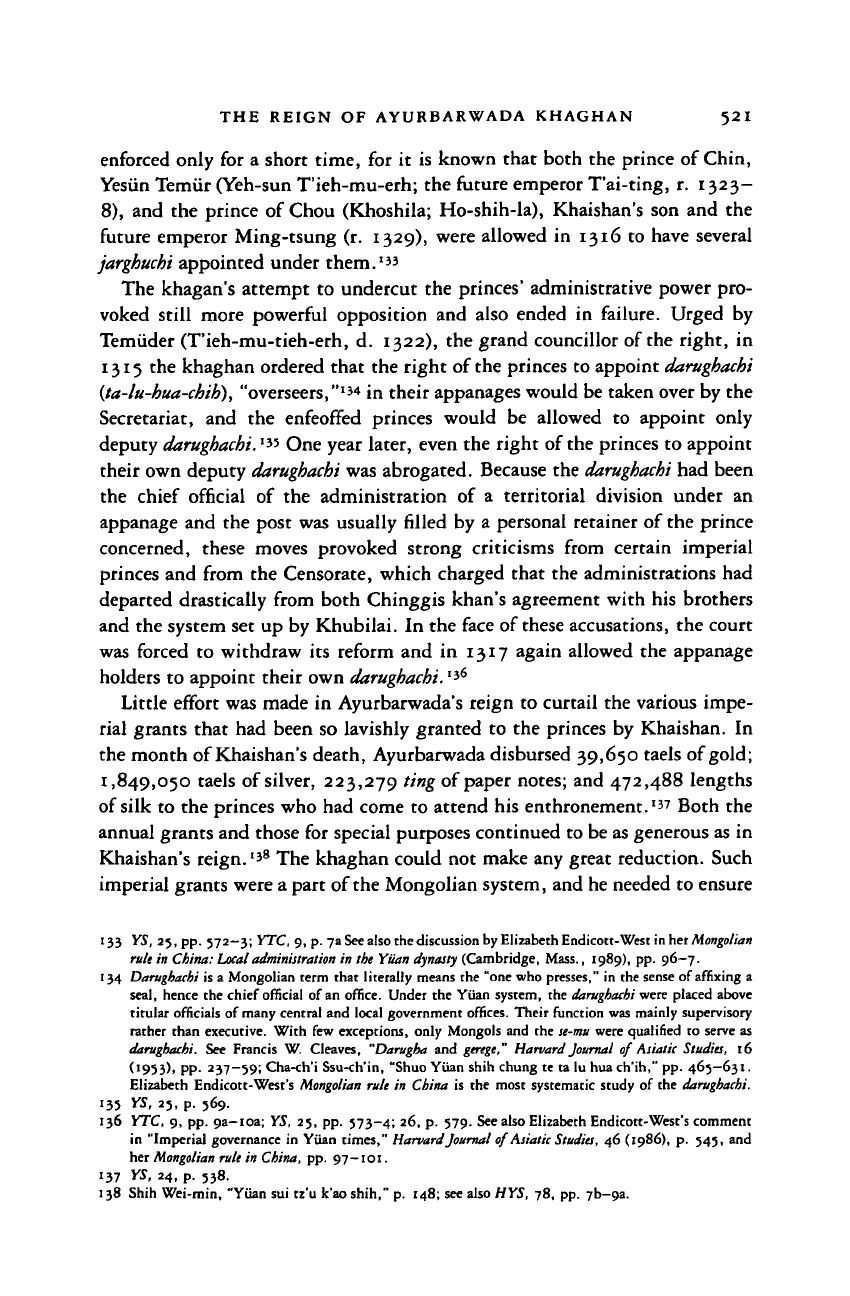
THE REIGN OF AYURBARWADA KHAGHAN 52I
enforced only for a short time, for it is known that both the prince of Chin,
Yesiin Temiir (Yen-sun Tieh-mu-erh; the future emperor T'ai-ting, r. 1323-
8),
and the prince of Chou (Khoshila; Ho-shih-la), Khaishan's son and the
future emperor Ming-tsung (r. 1329), were allowed in 1316 to have several
jarghuchi appointed under them.
133
The khagan's attempt to undercut the princes" administrative power pro-
voked still more powerful opposition and also ended in failure. Urged by
Temiider (T'ieh-mu-tieh-erh, d. 1322), the grand councillor of the right, in
1315 the khaghan ordered that the right of the princes to appoint
darughachi
(ta-lu-hua-chih), "overseers,"
134
in their appanages would be taken over by the
Secretariat, and the enfeoffed princes would be allowed to appoint only
deputy darughachi.
1
^ One year later, even the right of the princes to appoint
their own deputy
darughachi
was abrogated. Because the
darughachi
had been
the chief official of the administration of a territorial division under an
appanage and the post was usually filled by a personal retainer of the prince
concerned, these moves provoked strong criticisms from certain imperial
princes and from the Censorate, which charged that the administrations had
departed drastically from both Chinggis khan's agreement with his brothers
and the system set up by Khubilai. In the face of these accusations, the court
was forced to withdraw its reform and in 1317 again allowed the appanage
holders to appoint their own darughachi.
Ii6
Little effort was made in Ayurbarwada's reign to curtail the various impe-
rial grants that had been so lavishly granted to the princes by Khaishan. In
the month of Khaishan's death, Ayurbarwada disbursed 39,650 taels of gold;
1,849,050
taels of silver, 223,279 ting of paper notes; and 472,488 lengths
of silk to the princes who had come to attend his enthronement.'
37
Both the
annual grants and those for special purposes continued to be as generous as in
Khaishan's reign.'
38
The khaghan could not make any great reduction. Such
imperial grants were a part of the Mongolian system, and he needed to ensure
'33 Y$i 25, pp. 572—3; YTC, 9, p. 7a See also the discussion by Elizabeth Endicott-West in her
Mongolian
rule in China: Local administration in the Yiian dynasty (Cambridge, Mass., 1989), pp. 96—7.
134 Darughachi is a Mongolian term that literally means the "one who presses," in the sense of affixing a
seal, hence the chief official of an office. Under the Yiian system, the
darughachi
were placed above
titular officials of many central and local government offices. Their function was mainly supervisory
rather than executive. With few exceptions, only Mongols and the
se-mu
were qualified to serve as
darughachi. See Francis W. Cleaves, "Darugha and
gerege,"
Harvard
Journal
of Asiatic Studies, 16
(1953),
pp. 237—59; Cha-ch'i Ssu-ch'in, "Shuo Yiian shih chung te ta lu hua ch'ih," pp. 465—631.
Elizabeth Endicott-West's Mongolian rule in China is the most systematic study of the darughachi.
135 YS, 25, p. 569.
136 YTC, 9, pp. 9a-ioa; YS, 25, pp. 573-4; 26, p. 579. See also Elizabeth Endicott-West's comment
in "Imperial governance in Yiian times," Harvard Journal of Asiatic
Studies,
46 (1986), p. 545, and
her Mongolian rule in China, pp. 97-101.
137 YS, 24, p. 538.
138 Shih Wei-min, "Yuan sui tz'u k'ao shih," p. 148; see also HYS, 78, pp. 7b-9a.
Cambridge Histories Online © Cambridge University Press, 2008
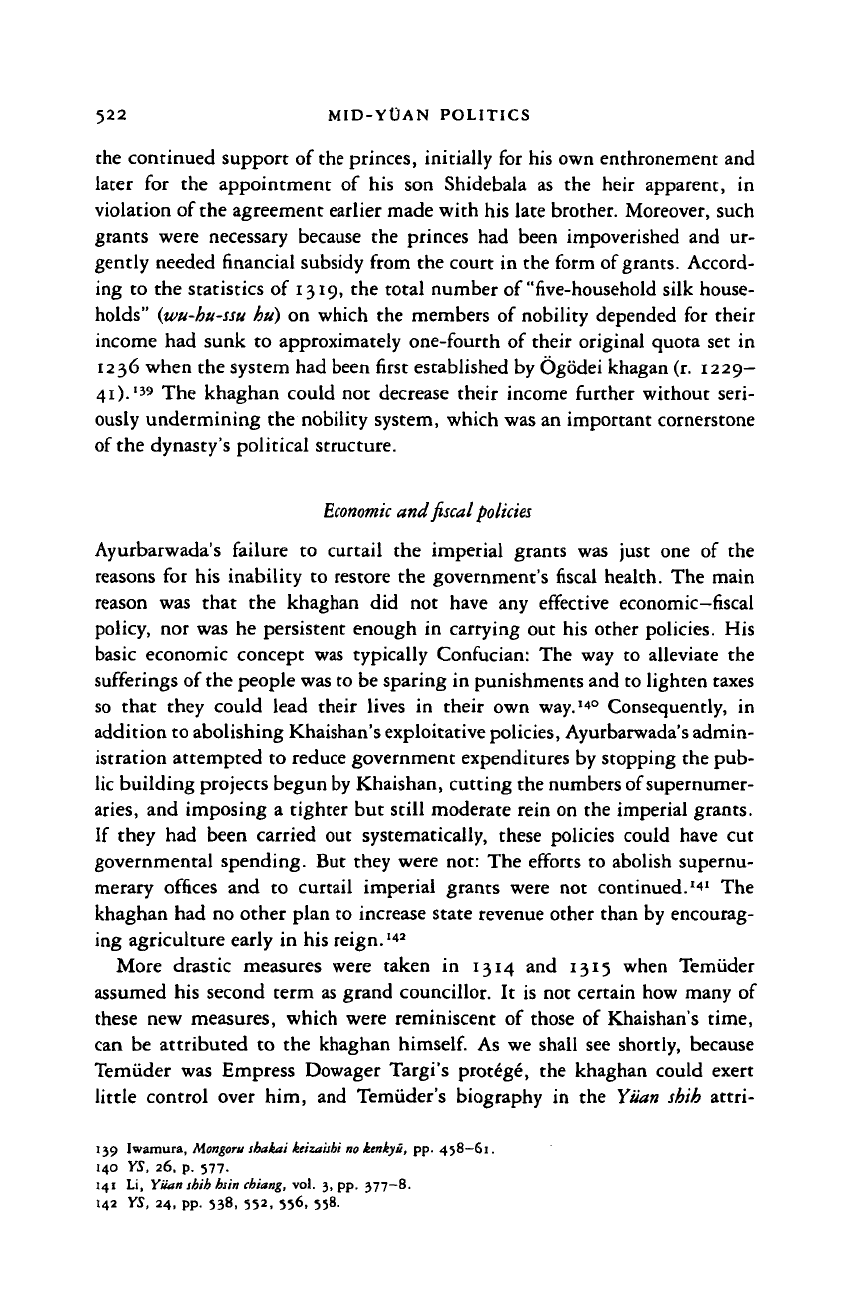
522 MID-YOAN POLITICS
the continued support of the princes, initially for his own enthronement and
later for the appointment of his son Shidebala as the heir apparent, in
violation of the agreement earlier made with his late brother. Moreover, such
grants were necessary because the princes had been impoverished and ur-
gently needed financial subsidy from the court in the form of
grants.
Accord-
ing to the statistics of 1319, the total number of "five-household silk house-
holds"
{wu-hu-ssu
hu) on which the members of nobility depended for their
income had sunk to approximately one-fourth of their original quota set in
1236 when the system had been first established by Ogodei khagan (r. 1229—
41).
139
The khaghan could not decrease their income further without seri-
ously undermining the nobility system, which was an important cornerstone
of the dynasty's political structure.
Economic
and fiscal policies
Ayurbarwada's failure to curtail the imperial grants was just one of the
reasons fot his inability to restore the government's fiscal health. The main
reason was that the khaghan did not have any effective economic-fiscal
policy, nor was he persistent enough in carrying out his other policies. His
basic economic concept was typically Confucian: The way to alleviate the
sufferings of the people was to be sparing in punishments and to lighten taxes
so that they could lead their lives in their own
way.
I4
°
Consequently, in
addition to abolishing Khaishan's exploitative
policies,
Ayurbarwada's admin-
istration attempted to reduce government expenditures by stopping the pub-
lic building projects begun
by
Khaishan, cutting the numbers of supernumer-
aries,
and imposing a tighter but still moderate rein on the imperial grants.
If they had been carried out systematically, these policies could have cut
governmental spending. But they were not: The efforts to abolish supernu-
merary offices and to curtail imperial grants were not continued."*
1
The
khaghan had no other plan to increase state revenue other than by encourag-
ing agriculture early in his reign.'
42
More drastic measures were taken in 1314 and 1315 when Temiider
assumed his second term as grand councillor. It is not certain how many of
these new measures, which were reminiscent of those of Khaishan's time,
can be attributed to the khaghan
himself.
As we shall see shortly, because
Temiider was Empress Dowager Targi's protege, the khaghan could exert
little control over him, and Temiider's biography in the Yuan shih attri-
139 Iwamura,
Mongoru
sbakai'•
keizaishi noktnkyu, pp. 458—61.
140 YS, 26, p. 577.
141 Li, Yuan sbih
hs'm
cbiang, vol. 3, pp. 377-8.
142 YS, 24, pp. 538, 552, 556, 558.
Cambridge Histories Online © Cambridge University Press, 2008
